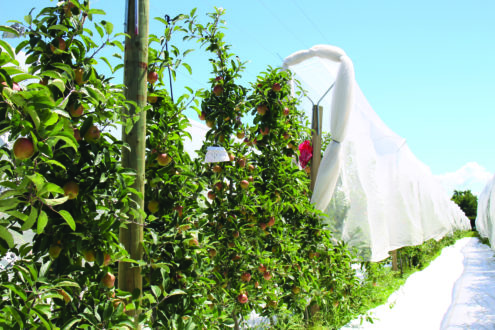

Feb 21, 2019Drape Net a viable option for orchard protection
An Australian product for tree fruit crop protection is making inroads to North America.
Drape Net is a system for literally draping trees with netting that – similar to more expensive netting systems built into trellis systems – protects the trees and fruit from hail, birds, pests and sun damage.
Australian origin
Drape Net was created by Michael Cunial in Australia about 15 years ago, said Helen Giroux-Taylor, sales manager for Drape Net North America. Cunial has been selling the Chinese-manufactured product in Australia and New Zealand since that time, and is now in use in New York, Michigan, Pennsylvania, Washington, Ontario and Quebec.
Her own family’s farm, Chazy Orchards in Chazy, New York, found the product when desperate for a hail protection measure.
“In a span of six years we had four major hail events,” Giroux-Taylor said. “We realized that with climate change and the unpredictable weather patterns becoming the norm, we had to do something to mitigate what seems to be turning into an ever-present risk. We got in touch with Michael through some people in the industry who had seen his product in New Zealand but hadn’t researched it much, they just knew it was out there and that it was a possibility.
“We traveled to New Zealand for a Drape Net field day and were blown away by the simplicity of the system,” she said. “We were able to watch and help put netting on a tree as well as take it off.”
While structured netting is prohibitively expensive for many growers, netting sells for $3,500 per acre and the applicator, called a Net Wizz, is $17,500.
Giroux-Taylor said the main purpose of the product is hail protection.
“The branches that Drape Net is resting on creates a little bit of tension in the netting that hail will just hit and either bounce or roll off of the netting,” Giroux-Taylor said. Besides that, Drape Net reduces bird damage, reduces sunburn, reduces wind damage, and helps with water retention.
Extension tested
The product was featured during the International Fruit Tree Association tours to New Zealand in February and March 2018. That led to Michigan State University (MSU) Extension educators Phil Schwallier and Amy Irish-Brown testing the product this summer, sharing their results at the recent Great Lakes Fruit, Vegetable and Farm Market EXPO in Grand Rapids.
“There are other types of netting, this just happens to be the company that we worked with because some of the growers in our area were working with it,” Irish-Brown said. The MSU trial of Drape Net took place during the summer of 2018 on apple orchards around Belding, Michigan, as well as at Clarksville.
Extension set insect traps and did visual scanning for pests.
“Spray materials can get through it, but most of the insects we looked at couldn’t get through it,” Irish-Brown said. Two exceptions are aphids and wooly aphids, which were small enough to get through the netting.
Data loggers also recorded humidity and temperatures in trials of no-net, white-net and black-net apple trees.
Temperatures were slightly higher under white netting than with no netting at all, she said, while humidity was highest under black netting. There were slight reductions in reddening, and “fruit maturity was delayed slightly inside the netting,” she said.
Casting nets


At Chazy Orchards, the growers first used the netting on 50 acres, and since have expanded their use to put 150 acres under netting.
Giroux-Taylor said putting Drape Net on in the spring requires a five-person crew: “One tractor driver, two people guiding the net down and two people putting zip ties in every 20 to 30 feet.”
She added it could be taken off with a smaller, three-person crew.
“You could have them go through before and cut the zip ties on the row you are about to take off, and then come back to help guide the netting off of the tree,” she said.
Starting out, Drape Net can be applied at a pace of 5 acres per day – the pace goes twice as quickly in following years after the 100-meter bolts of netting are cut and sewn to the right length for each row.
Drape Net can last for at least 10 years, Giroux-Taylor said. The company sells products for storing the rolls outside.
Troubleshooting
One grower attending the presentation in Grand Rapids told a story about how 10 minutes of 70 mph winds had nearly toppled a couple rows of trees he had netted.
“In regards to wind, Drape Net will not act like a sail but if the trellis was going to blow over without Drape Net on, putting Drape Net on will not help,” Giroux-Taylor said. “You want to be confident in your trellis system in high winds before you put Drape Net on.”
Most growers zip-tie the bottom of the netting to the trees’ bottom branches, she said.
“We don’t suggest securing Drape Net to the ground,” Giroux-Taylor said. “If you would like to use Drape Net as exclusion netting you can bring the netting all the way underneath the tree and zip tie it to itself on the other side.”
Irish-Brown said that if the net isn’t cinched at the bottom, “A moth could be clever and try to get up in there,” or other insects like apple maggot could crawl up from the ground.
But an uncinched net is also helpful to gain entry to the trees.
“You can work in there, but it can be a tight fit, depending on the planting,” she said.
– Stephen Kloosterman, FGN Associate Editor
Above: The main purpose of Drape Net is to provide hail protection. Photos: Gary Pullano














